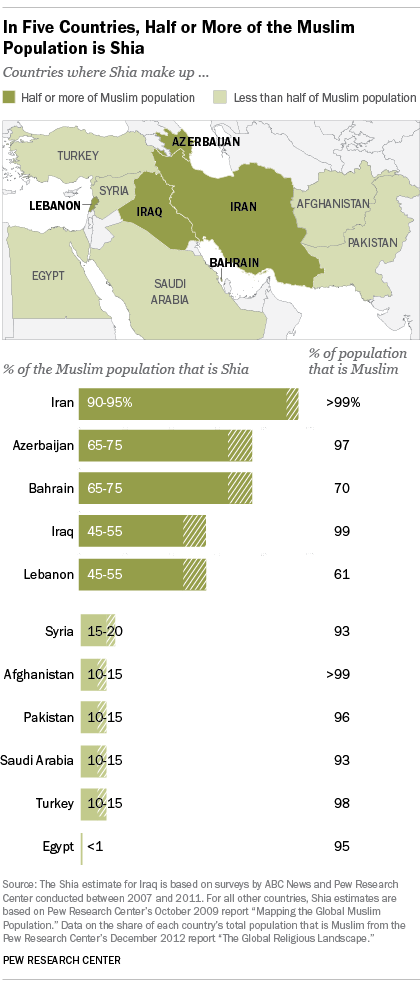The ongoing and intensifying conflict in Iraq has fallen – at least in part – along sectarian lines, with the Sunni Muslim militant group ISIS (the Islamic State in Iraq and Syria) advancing against the Shia Muslim-led Iraqi government and Shia militias. Sectarian affiliation has played a role in the politics of the region for hundreds of years.

Iran and Iraq are two of only a handful of countries that have more Shias than Sunnis. While it is widely assumed that Iraq has a Shia majority, there is little reliable data on the exact Sunni-Shia breakdown of the population there, particularly since refugees arriving in Iraq due to the conflict in Syria or leaving Iraq due to its own turmoil may have affected the composition of Iraq’s population.
The few available survey measures of religious identity in Iraq suggest that about half the country is Shia. Surveys by ABC News found between 47% and 51% of the country identifying as Shia between 2007 and 2009, and a Pew Research survey conducted in Iraq in late 2011 found that 51% of Iraqi Muslims said they were Shia (compared with 42% saying they were Sunni).
Neighboring Iran is home to the world’s largest Shia population: Between 90% and 95% of Iranian Muslims (66-70 million people) were Shias in 2009, according to our estimate from that year.
Their shared demographic makeup may help explain Iran’s support for Iraq’s Shia-dominated government led by Prime Minister Nouri al-Maliki.
Iran also has supported Bashar al-Assad’s government in Syria, where only 15-20% of the Muslim population was Shia as of 2009. But the Syrian leadership is dominated by Alawites (an offshoot of Shia Islam). Under Saddam Hussein’s regime in Iraq, which was dominated by Sunnis, the country clashed with Iran.
The Sunni-Shia divide is nearly 1,400 years old, dating back to a dispute over the succession of leadership in the Muslim community following the death of the Prophet Muhammad in 632.
Despite periods of open conflict between Sunnis and Shias in countries such as Lebanon and Iraq, the two groups are not all that different in terms of religious beliefs and commitment. In Iraq, for example, both groups express virtually universal belief in God and the Prophet Muhammad, and similar percentages (82% of Shias and 83% of Sunnis) say religion is very important in their lives. More than nine-in-ten Iraqi Shias (93%) and Sunnis (96%) say they fast during the holy month of Ramadan.
In some countries, significant shares of Muslims don’t even see the distinction between Sunni and Shia Islam as relevant. A survey of Muslims in 39 countries that we conducted in 2011 and 2012 found, for example, that 74% of Muslims in Kazakhstan and 56% of Muslims in Indonesia identified themselves as neither Sunni nor Shia, but “just a Muslim.” In Iraq, however, only 5% answered “just a Muslim.”
On some religious issues, including whether it is acceptable to visit the shrines of Muslim saints, the differences between the sects are more apparent. For some, the divide is even exclusionary. In late 2011, 14% of Iraqi Sunnis said they do not consider Shias to be Muslims. (By contrast, only 1% of Shias in Iraq said that Sunnis are not Muslims.) Even higher percentages of Sunnis in other countries, such as Sunni-dominated Egypt (53%), say that Shias are not Muslims.
